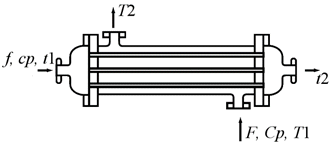EQUATRAN on the web
Lesson 2 : Heat Balance of Heat Exchanger
Let's solve linear simultaneous equations.

A hot process fluid flows into the heat exchanger with a flow rate f and a temperature t1.
The specific heat capacity is cp.
Cooling water flows through the other side of the exchanger with flow rate F, temperature T1 and heat capacity Cp.
The two streams leave at temperatures of t2 and T2 and the heat duty exchanged is Q.
The heat balance can be described by the 2 equations:

(2-1)
We enter the equations which calculate the heat duty Q from heat balance,
and calculate f from F, T1, T2, t1 and t2.
- The asterisk mark (*) is used to represent multiplication.
- More than one equation can be added on a line of text, separated by a semi-colon(;).
- Comments can be added at the end of a line, preceded by //.
- The OUTPUT statement lets us specify the variables to be reported in the results. This is useful as the problems become more complex as we do not necessarily want to see all the input values repeated in the output.

(2-2)
Next, let's give the flow rate f of cooling water and ask for the outlet temperature t2.

(2-3)
We add the heat transfer equation expressed by the overall heat transfer coefficient U and the logarithmic mean temperature difference dT, give the heat transfer area A on the same conditions as (2-1), and calculate U.


(2-4)
The following problem calculates the outlet temperature T2 and t2 of two fluid by giving A and U. It is a problem which solves nonlinear simultaneous equations.
- The RESET statement is used to define the iterative caluculation. "#" means an initial value, and in the BY clause, the equation that verifies the convergence is specified. "eq" is the label attached to the equation.

Sample problem
The following sample problems will help you understand how EQUATRAN-G works.
Lesson 1 : Antoine Equation
Lesson 2 : Heat Balance of Heat Exchanger
Lesson 3 : Boiling Point Calculation
Lesson 4 : Reaction Calculation
Lesson 5 : Simple Distillation
Top page of Modeling Software